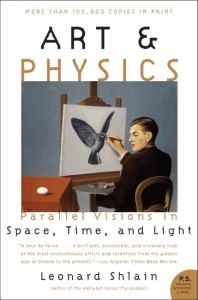 Last summer, I started reading Art & Physics on the recommendation of my son, who actually read it at the suggestion of a teacher a few years ago. It was quite the routine — I would go outside in the late afternoon, read for an hour or two, and then get ready to go to the Coaster Theatre, where I was performing the role of Senex (the dirty old man) in A Funny Thing Happened on the Way to the Forum.
Last summer, I started reading Art & Physics on the recommendation of my son, who actually read it at the suggestion of a teacher a few years ago. It was quite the routine — I would go outside in the late afternoon, read for an hour or two, and then get ready to go to the Coaster Theatre, where I was performing the role of Senex (the dirty old man) in A Funny Thing Happened on the Way to the Forum.
Unfortunately, even though the book is only a little over 400 pages long, I was unable to finish it last summer (my son read it in a week or two). So finally, after seeing it on the coffee table for almost a year, I picked it up and finished it recently. I’m glad I did.
Schlain’s thesis is that “revolutionary artists’ imagery contains crucial insights that underlie the conceptual framework of how society sees the world. Later, these insights most often shine through visionary physicists’ equations and subsequently change the way the rest of us think about the world.” The author, in the chapter entitled I/We, goes on to ask, “How could so many diverse artists throughout different centuries, virtually all of them unaware of what was about to happen in the field of physics, manage to bring forth so many innovative styles of art that spoke directly to the imminent re-visioning of physical reality in the their times?”
To answer that $64 million question, Schlain ventures into evolutionary theory, brain lateralization and mythology! These last chapters tie together a fascinating book, the bulk of which is a survey of art and physics revolutions and the people who made them. Anyone interested in history and Western culture will find the book illuminating, and for those with only a basic understanding of physics, Schlain does a good job in explaining difficult concepts like relativity, quantum mechanics and black holes. For me, the chapters on art (which tended to alternate with those on physics) were quite revealing, even though the illustrations of the paintings were only in black and white. Discussions of perspective, use of light and space, movements like fauvism, cubism, futurism and surrealism, and the background of the painters, gave me a new appreciation for some art that I considered ridiculous before reading this book.
I’ve been studying the scientific field of complexity for many decades now, and Schlain’s description of an anthill and the ants that make it as an example of universal mind (in the 4th dimension) and the minds that make it up is classic. And Schlain goes further — he talks about the American philosopher William James and his theory of “cosmic consciousness”, which James proposed was G-d, and the Catholic theologian Pierre Teilhard de Chardin, who “posited the existence of a membrane of consciousness girdling the globe, which he was careful not to call G-d.”
So, in those last few chapters that I didn’t get to until recently, Schlain deviates from the core of the book and tries to explain how artists can incorporate ideas in their work before they were discovered by brilliant physicists, and before the vast majority of us even thought about them, using the concept of universal mind. In explaining this, he goes into left and right brain differences, Greek mythology, and finally, the concept of the spacetime continuum (yes, it all sounds like Star Trek!), where time is not linear, there is no past, present or future, and everything happens all at once everywhere. Quite mind-blowing!
Unfortunately, Leonard Schlain died a few years ago, so there won’t be a sequel to Art & Physics, and I can’t ask him what the heck it all means. Too bad. Here was a man who practiced medicine his whole life, and was diagnosed with non-Hodgkins lymphoma when he was in his 30s. Fortunately, he lived for 40 more years, and has written a couple other really interesting books that I’ll probably get to sooner or later.
Bottom line – get this book, even if you only look at the pictures. There’s a lot of great art in it, and the illustrations explaining the physics concepts are excellent. Let me know what you think, especially if you make it all the way through. The bridging of science and religion is even more profound than the bridging of art and physics.
Leave a Reply